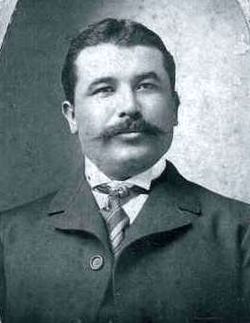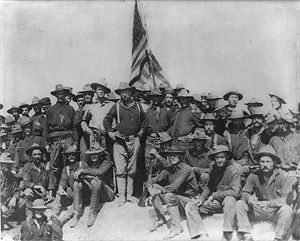
Juan Alamia
Encyclopedia

Mexican Revolution
The Mexican Revolution was a major armed struggle that started in 1910, with an uprising led by Francisco I. Madero against longtime autocrat Porfirio Díaz. The Revolution was characterized by several socialist, liberal, anarchist, populist, and agrarianist movements. Over time the Revolution...
.
Juan Alamia was born (abt. 1876) to Benito Alamia and Francisca Ybarra in Point Isabel, Texas
Texas
Texas is the second largest U.S. state by both area and population, and the largest state by area in the contiguous United States.The name, based on the Caddo word "Tejas" meaning "friends" or "allies", was applied by the Spanish to the Caddo themselves and to the region of their settlement in...
(now known as Port Isabel). His siblings were Jose Roman Alamia (1877–1924), Maria de la Paz Alamia (1853–1929), Gregoria Alamia, Vivian Alamia, Lorenzo Alamia, Antonio Alamia, Bernardo Alamia, Julio Alamia, and Josefina Alamia.
Alamia married Maria Kohlman (1874–1945), a New Mexico territory native, in 1901. They had three children: Mary F. Alamia (1901–1912), Peter Ciro Alamia (1902–1948), and Joseph Albert Alamia (1908–1957).
Rough Rider

The conflict between Spain
Spain
Spain , officially the Kingdom of Spain languages]] under the European Charter for Regional or Minority Languages. In each of these, Spain's official name is as follows:;;;;;;), is a country and member state of the European Union located in southwestern Europe on the Iberian Peninsula...
and the United States
United States
The United States of America is a federal constitutional republic comprising fifty states and a federal district...
centered on the question of Cuba
Cuba
The Republic of Cuba is an island nation in the Caribbean. The nation of Cuba consists of the main island of Cuba, the Isla de la Juventud, and several archipelagos. Havana is the largest city in Cuba and the country's capital. Santiago de Cuba is the second largest city...
, where for several years insurgents had been fighting a guerrilla war against their colonial rulers; on April 20, 1898, the U.S. Congress recognized Cuban independence and simultaneously authorized the use of American military force to ensure it; four days later, Spain declared war on the United States.
Alamia's regiment trained at Camp Wood in San Antonio for a month before embarking for Cuba; the unit's first commander, Leonard Wood
Leonard Wood
Leonard Wood was a physician who served as the Chief of Staff of the United States Army, Military Governor of Cuba and Governor General of the Philippines. Early in his military career, he received the Medal of Honor. Wood also holds officer service #2 in the Regular Army...
, was soon replaced by his second-in-command, Theodore Roosevelt
Theodore Roosevelt
Theodore "Teddy" Roosevelt was the 26th President of the United States . He is noted for his exuberant personality, range of interests and achievements, and his leadership of the Progressive Movement, as well as his "cowboy" persona and robust masculinity...
; known affectionately as the Rough Riders, these troops won fame for their successful assaults on Kettle and San Juan hills, near the city of Santiago, on July 1, 1898.
Battles of Reynosa and Matamoros, Tamaulipas
While living in Brownsville, TexasBrownsville, Texas
Brownsville is a city in the southernmost tip of the state of Texas, in the United States. It is located on the northern bank of the Rio Grande, directly north and across the border from Matamoros, Tamaulipas, Mexico. Brownsville is the 16th largest city in the state of Texas with a population of...
Juan Alamia worked as a telegrapher for Western Union
Western Union
The Western Union Company is a financial services and communications company based in the United States. Its North American headquarters is in Englewood, Colorado. Up until 2006, Western Union was the best-known U.S...
along with his younger brother, Jose Roman. His work took him across the river to Matamoros, Mexico
Mexico
The United Mexican States , commonly known as Mexico , is a federal constitutional republic in North America. It is bordered on the north by the United States; on the south and west by the Pacific Ocean; on the southeast by Guatemala, Belize, and the Caribbean Sea; and on the east by the Gulf of...
. Supporters of Lucio Blanco
Lucio Blanco
Lucio Blanco was a Mexican military officer, noteworthy for his participation in the Mexican Revolution of 1910 to 1920.-Biography:...
, one of Carranza's generals, ordered Alamia to send a wire message to Mexico City telling opposing forces that all was serene in Matamoros and to come on into the city. In fact, Blanco and his supporters were laying a trap. Alamia failed to follow the directions he was given and sent a communication to Mexico City of the true circumstances on the border.
Death
On May 9, 1913 Lucio Blanco captured the town of Reynosa, Mexico. Blanco's attack killed twenty-one of the defenders and drove many across the river into Texas. Between Reynosa and Matamoros is a place called Río BravoRío Bravo, Tamaulipas
Río Bravo formally Ciudad Río Bravo is a city in northern part of the Mexican state of Tamaulipas. It is the municipal seat of Río Bravo Municipality. The city lies east of Reynosa and just south of the Río Bravo del Norte and was also named after it. Directly across the U.S.-Mexico border lies...
.
On May 10, 1913 Lucio Blanco appeared at Río Bravo, Mexico. This is located 40 miles west from the cities of Brownsville and Matamoros.
Alamia and eleven others were confronted by Lucio Blanco and his men. The twelve were asked and declined to join the army being led by Blanco. The twelve were taken prisoner and executed.
To display his disdain for Americans, he strung Alamia and two others from a mesquite tree.
His death occurred on May 11, 1913 in Rio Bravo, Mexico.
Captain Everette Anglin gave testimony before a committee of the Foreign Relations Committee of the United States Senate (66th Congress) investigating the outrages of citizens of the United States in Mexico. From his first hand testimony we learn of some of the circumstances surrounding Alamia's death.
Anglin, unaware of Blanco's capabilities, arrived at Blanco's camp at Rio Bravo attempting to reclaim horses belonging to Texans from the Rancho Salteña. Blanco refused to return them because he needed them. After Anglin protested that they belonged to Americans Blanco showed his disdain for Americans pointing to Alamia whose body and the other two men were still hanging from a tree near the river bank. Anglin was horrified at the site of Alamia in that the two were friends. Anglin returned to the United States where he reported the incident to Juan Alamia's brother Jose Roman Alamia who was then serving as Hidalgo County
Hidalgo County, Texas
Hidalgo County is a county located in the U.S. state of Texas. Located in the Rio Grande Valley of South Texas, Hidalgo County is one of the fastest-growing counties in the United States, and is the seventh most-populous county in Texas. Its population in 2010 was 774,769, a 35% increase from 2000...
's tax collector.
The ranch where he was executed is known as "Las Alacranes" which translates to the scorpions. The ranch has been held by the Garza family for many generations as it is today. A lady in the Garza family cut Juan Alamia down from the tree where he was hanging. Others feared cutting him down for fear of retribution from General Blanco. She hitched her wagon and went to the place were Alamia and another man were hanging. She put his body in the wagon and took it to a place across the river from Bill Brewster's Ranch were a person in a skiff took the body across the river.
He was then buried in the family plot in the old Brownsville cemetery.
His life went unrecognized for years except for a corrido still sung in Rio Bravo and amongst the Garza family at "Las Alacranes" ranch in Rio Bravo, Mexico. Upon the marriage of a descendant of Juan Alamia and the brave lady who retrieved his body from the mesquite tree, the story in the corrido
Corrido
The corrido is a popular narrative song and poetry form, a ballad, of Mexico. The songs are often about oppression, history, daily life for peasants, and other socially important information. It is still a popular form today, and was widely popular during the Mexican Revolution and Nicaraguan...
was shared. Adrienne Peña-Garza told her father, a member of the state legislature
Aaron Peña
Aaron Peña, Jr. , is a member of the Texas House of Representatives from a district in Hidalgo County in far South Texas. In November 2002, he was first elected to the Texas House of Representatives as a Democrat. He is serving his fifth term in office. Representative Peña is an attorney in private...
, of the story shared with her by her husband Aquiles Jaime Garza. Her father found the crumbling tomb of Juan Alamia in the old Brownsville cemetery and searched through old family records to piece together his story so that it could be told. On August 5, 2003, the Texas Legislature honored the life and service of this brave and nearly forgotten American with a resolution telling his story.

